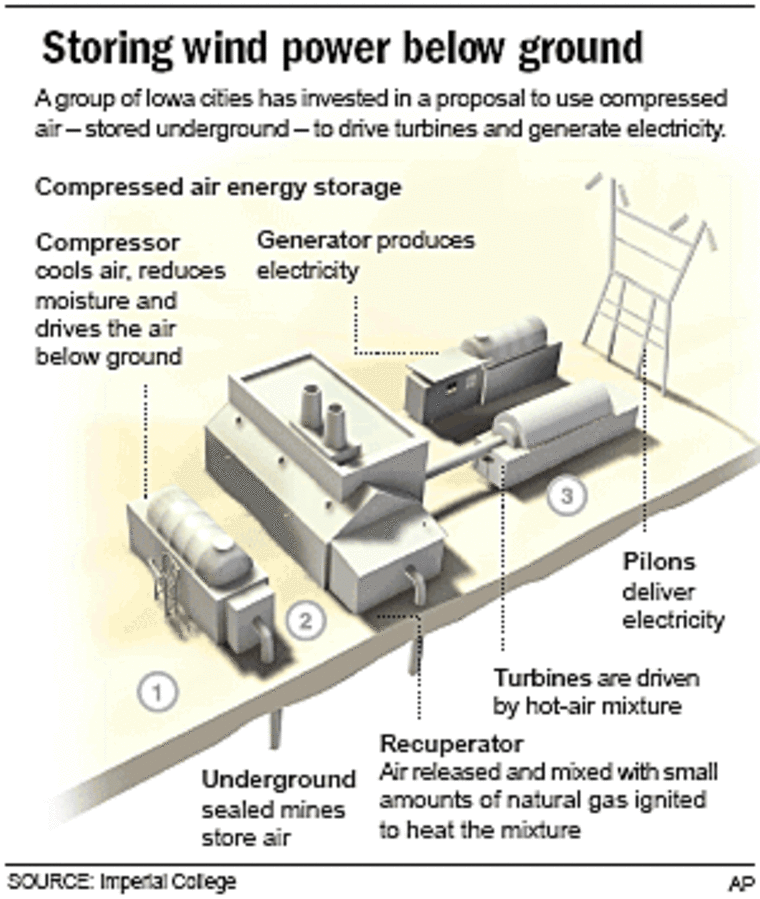A group of Iowa cities intends to not only harness the wind, but also capture it, store it underground and use it to help make electricity when demand peaks.
Members of the Iowa Association of Municipal Utilities have invested in a proposed power plant that would use wind turbines to drive compressed air into underground aquifers. The air would be released to generate electricity when needed.
It's a new twist on the idea of using wind energy in a way that removes the unreliability of nature.
"Wind energy is dependent upon whether the wind is blowing or not," said Bob Haug, executive director of the Iowa Association of Municipal Utilities. "But if you can use the compressed air as a storage medium, you get the certainty and the dispatchability that you need to make wind compete."
The plant will use power from its own wind turbines, supplemented by cheaper electricity bought at off-peak times, to force air into rock formations at least 2,000 feet underground.
Current plans call for pressurized storage of tens of billions of cubic feet of air in rock formations deep underground.
Natural gas to help
When it is needed, the air will be released and mixed with small amounts of natural gas to power electricity-generating turbines.
"We've done quite a few studies in last couple of years and the economics look very favorable," said Tom Wind, an energy consultant who is a technical adviser on the Iowa Stored Energy Plant project.
Haug said the plant would use a third to half the amount of natural gas needed by conventional turbines. However, instead of natural gas, the plant could burn biomass such as corn stalks or switchgrass.
"In the future, we could get very close to a totally renewable plant," he said.

The idea of pursuing the wind storage plant came as the municipal utilities were considering investing in their own electricity generating plant in 2001. The group first considered a coal-fired plant, but began considering the increasing cost of environmental regulations and the impact coal plants have on the environment.
"For us, it's really risk management," Haug said. "We know generating electricity with coal produces mercury and that's dangerous to the health of our children."
Global warming also focuses attention on renewable, clean energy sources, he said.
The project, backed by 74 members of the municipal utilities group, obtained a $1.2 million U.S. Department of Energy grant last year to study the idea. It anticipates another $1 million this year to continue to evaluate the project's feasibility. About $700,000 has been raised by the utilities that support the idea.
Organizers also plan to seek support from major utilities, Wind said.
Two earlier plants
Only two other underground compressed air plants are in operation. A plant in Huntorf, Germany, was built more than 23 years ago and a plant in McIntosh, Ala., is 11 years old. Both store compressed air in underground salt caverns.
Iowa's project is unique in that it would use wind power to store the air and combine it with massive underground storage capacity.
The Germany and Alabama plants store hundreds of thousands of cubic feet of air in a thermos-bottle shaped container installed in the salt mines. The Iowa project would use naturally occurring pockets embedded in sand or sandstone formations sealed by shale or other rock.
The area, which would cover hundreds of acres of land, could store tens of billions of cubic feet of air, Haug said. That capacity would allow the wind energy plant to compete with fossil fuel plants.
The ground above the storage area would remain undisturbed. The group building the plant would need only to acquire leasing rights to the underground storage, Haug said.
The Iowa project's initial plans call for construction of a 100 megawatt wind farm and a 200 megawatt compressed air energy storage plant.
The plant is expected to cost about $300 million. A site has not yet been chosen, but it likely will be in central Iowa, where suitable underground formations are known to exist, Haug said.
Plans call for the plant to go online by 2010.